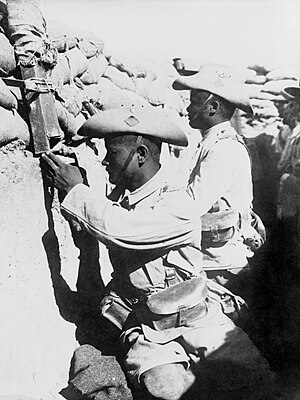| Battle of Mughar Ridge | |||||||
|---|---|---|---|---|---|---|---|
| Part of the Middle Eastern theatre of World War I | |||||||
 3/3rd Gurkha Rifles holding front line trenches | |||||||
| |||||||
| Belligerents | |||||||
|
| |||||||
| Commanders and leaders | |||||||
|
|
| ||||||
| Units involved | |||||||
|
XXI Corps Desert Mounted Corps |
Seventh Army Eighth Army | ||||||
| Casualties and losses | |||||||
| 1,188+ |
10,000 prisoners, 100 guns | ||||||
The Battle of Mughar Ridge, officially known by the British as the action of El Mughar, took place on 13 November 1917 during the Pursuit phase of the Southern Palestine Offensive of the Sinai and Palestine Campaign in the First World War. Fighting between the advancing Egyptian Expeditionary Force (EEF) and the retreating Yildirim Army Group, occurred after the Battle of Beersheba and the Third Battle of Gaza. Operations occurred over an extensive area north of the Gaza to Beersheba line and west of the road from Beersheba to Jerusalem via Hebron.[1]
Strong Ottoman Army positions from Gaza to the foothills of the Judean Hills had successfully held out against British Empire forces for a week after the Ottoman army was defeated at Beersheba. But the next day, 8 November, the main Ottoman base at Sheria was captured after two days' fighting and a British Yeomanry cavalry charge at Huj captured guns; Ottoman units along the whole line were in retreat.
The XXI Corps and Desert Mounted Corps attacked the Ottoman Eighth Army on an extended front from the Judean foothills across the Mediterranean coastal plain from 10 to 14 November. Beginning on 10 November at Summil, an Ottoman counterattack by the Seventh Army was eventually blocked by mounted units while on 13 November in the centre a cavalry charge assisted by infantry captured two fortified villages and on 14 November, to the north at Ayun Kara an Ottoman rearguard position was successfully attacked by mounted units. Junction Station (also known as Wadi es Sara) was captured and the Ottoman railway link with Jerusalem was cut. As a result of this victory the Ottoman Eighth Army withdrew behind the Nahr el Auja and their Seventh Army withdrew toward Jerusalem.
- ^ Battles Nomenclature Committee 1922, p. 32